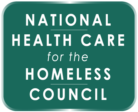Menu: HCH | A Vision of Health for All – Pages
Health Care for the Homeless: A Vision of Health for All
Conclusion
As Kevin Lindamood stated, “You find your next chapter in what you’ve already written. There are seeds in our history for what our future is and needs to be. In terms of the evolution of our systems, our goal was to put ourselves out of business—to train other health care providers to take care of our patients. That hasn’t happened.”
The HCH movement did not develop within a vacuum, but rather grew out of other social justice and health care movements in the U.S. in the 1960s and 1970s. HCH has direct ties with the organizers and policymakers involved in the CHC movement.
Key figures in the CHC movement were directly influenced by the World Health Organization’s community-based primary care model. Teasing out the specific tensions and differences between the mission, values, and activities of HCH vis-à-vis CHC would be a fruitful future endeavor.
It is interesting to note that the roots of the CHC movement were mainly within a Southern rural, impoverished community that lacked any organized health care services, while the roots of HCH were within a large metropolitan, mission-focused hospital system. Also, the CHC movement has garnered considerable bipartisan support over the past 20 years, while sub-population focused programs like HCH have also grown, but mainly from being folded into the CHC model of care.
There was considerable discussion of the role of HCH within the rapidly changing U.S. health care system. Pioneers pointed out that there was a growing chasm of opportunity and experience between HCH programs in Medicaid expansion states versus those in non-Medicaid expansion states. Many speakers highlighted key aspects of HCH that have now been adopted by the larger health care system:
- Team-based care models.
- Provision of comprehensive, wraparound health services.
- Development of medical hospice.
- Outreach programs aimed at reducing unnecessary ED visits and hospitalizations.
- Emphasis on the message that housing is health care.
- Patient-centered medical homes.
- Inclusion of motivational interviewing and trauma-informed care.
Points of difference that emerged in the Pioneers Session had to do with whether or not ending homelessness was an explicit goal of the HCH movement from the beginning. Several of the speakers from the original RWJ-Pew HCH demonstration program spoke of being dismayed that 30 years later they still have a job and that the U.S. still has the problem of homelessness.
Other speakers responded to this by pointing out that the original RWJ-Pew HCH Program mandate was to help change the overall health care system so that it would be more responsive to the needs of vulnerable populations, including those experiencing homelessness—and that while HCH has done a good job with that, there is still considerable work to be done.
Related to this was a thread throughout the discussion of the role of HCH in continuing to advocate for a single-payer health care system, with Pioneers pointing to the fact that such a health care justice perspective had been an original part of the HCH mission and policy work.
As Wright and Weber wrote in their Homelessness and Health report 30 years ago, “Better access to health care for homeless Americans is only the first step in what one hopes will be a renewed national commitment to quality health care for all, even for the poorest among us.”[1] (p. 159)


